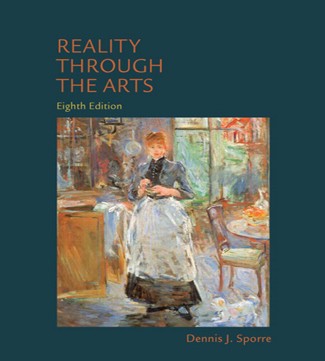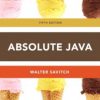Reality Through the Arts 8th Edition Sporre Test Bank
$35.00 Original price was: $35.00.$26.50Current price is: $26.50.
Reality Through the Arts 8th Edition Sporre Test Bank
This is completed downloadable of Reality Through the Arts 8th Edition Sporre Test Bank

Product Details:
- ISBN-10 : 0205858228
- ISBN-13 : 978-0205858224
- Author: Dennis J. Sporre
Thematic and Chronological Approach to the Humanities Reality Through the Arts is a popular choice for professors because it provides both a topical and chronological approach to the humanities. Part I, “The Media of the Arts,” offers independent chapters on two dimensional art (drawing, painting, printmaking, and photography), sculpture, architecture, music, literature, theatre, cinema, and dance. Part II, “The Styles of the Arts,” is a chronological history of the arts of Africa, the Americas, Asia, Europe, and the Middle East, organized by artistic discipline and focusing on styles rather than encyclopedic detail. This edition continues its uniquely flexible organization, allowing readers to cover individual art forms and historical context. In addition, the eighth edition is now available with MySearchLab, an online program that includes an interactive etext, assessment, and help with research and writing. A better teaching and learning experience This program will provide a better teaching and learning experience– for you and your students. Here’s how:
- Personalize Learning – The new MySearchLab delivers proven results in helping students succeed, provides engaging experiences that personalize learning, and comes from a trusted partner with educational expertise and a deep commitment to helping students and instructors achieve their goals.
- Improve Critical Thinking – Questions about specific issues appear at the end of each chapter, helping students develop their analytical skills.
- Engage Students – Human Reality features and vibrant illustrations throughout the book give students a further understanding of the artistic process.
- Support Instructors – New MySearchLab, Music for Humanities CD, Instructor’s Manual and Test Bank are available for this text.
Table of Content:
Chapter ONE: TWO-DIMENSIONAL ART
Multiple Choice Questions
1) Which of the following is considered the foundation of two-dimensional art?
a) drawing
b) painting
c) sculpture
d) printmaking
Answer: a
Page reference: Page 39
A-Head: Formal and Technical Qualities
2) Chalk, charcoal, pastel, and graphite are what kind of materials?
a) wet media
b) soft media
c) dry media
d) hard media
Answer: c
Page reference: Page 39
A-Head: Formal and Technical Qualities
3) Pen and ink, and wash and brush are what kind of materials?
a) dry media
b) wet media
c) soft media
d) hard media
Answer: b
Page reference: Page 39
A-Head: Formal and Technical Qualities
4) The popularity of oil paintings stems from what fact?
a) are inexpensive and can be easily purchased
b) have a long lifespan
c) are fast-drying
d) offer a wide range of color possibilities and can be reworked
Answer: d
Page reference: Page 42
A-Head: Formal and Technical Qualities
5) What painting media traditionally refers to a transparent paint usually applied to paper?
a) watercolor
b) acrylic
c) tempera
d) fresco
Answer: a
Page reference: Page 42
A-Head: Formal and Technical Qualities
6) Michelangelo’s Sistine Chapel is an example of what kind of painting media?
a) tempera
b) oil
c) fresco
d) mixed media
Answer: c
Page reference: Page 43
A-Head: Formal and Technical Qualities
7) What printing technique includes etching, drypoint and aquatint?
a) intaglio
b) relief
c) lithography
d) planography
Answer: a
Page reference: Page 44
A-Head: Formal and Technical Qualities
8) Albrecht Durer’s Lamentation, 1497-1500 is an example of what kind of printmaking technique?
a) lithography
b) woodcut
c) silkscreen
d) intaglio
Answer: b
Page reference: Page 44
A-Head: Formal and Technical Qualities
9) Which of the following is the most common stencil processes?
a) monotype
b) aquatint
c) silkscreen
d) etching
Answer: c
Page reference: Page 47
A-Head: Formal and Technical Qualities
10) Which artist is considered the driving force behind recognition of photography as a fine art?
a) Ansel Adams
b) Man Ray
c) Dorothea Lange
d) Alfred Stieglitz
Answer: d
Page reference: Page 49
A-Head: Formal and Technical Qualities
11) Dorothea Lange’s Dust Bowl Farm in Texas, 1936 is an example of what kind of photography?
a) straight
b) photogram
c) documentary
d) camera obscura
Answer: c
Page reference: Page 49
A-Head: Formal and Technical Qualities
12) To copy nature accurately, artists of the sixteenth century used what photographic technique:
a) daguerreotype
b) camera obscura
c) photogenesis
d) calotype
Answer: b
Page reference: Page 50
A-Head: Formal and Technical Qualities
13) What photographic technology has rendered film obsolete?
a) digital
b) photogenesis
c) calotype
d) wet-plate collodion
Answer: a
Page reference: 51
A-Head: Formal and Technical Qualities
14) What is the basic building block of any design?
a) shape
b) space
c) color
d) line
Answer: d
Page reference: Page 51
A-Head: Formal and Technical Qualities
15) Hung Liu utilizes what kinds of lines in her painting 2005 painting, Relic 12? (Hung Liu is a female artist. There is a typo in the text.)
a) expressive and straight
b) contour and dominant
c) classical and curved
d) implied and outline
Answer: d
Page reference: Page 53
A-Head: Formal and Technical Qualities
16) What term denotes the measurable wavelength of a specific color?
a) tint
b) shade
c) hue
d) value
Answer: c
Page reference: Page 55
A-Head: Formal and Technical Qualities
17) Adding white to any color is called a
a) shade
b) tint
c) value
d) hue
Answer: b
Page reference: Page 55
A-Head: Formal and Technical Qualities
18) The hues red, yellow and blue are what kinds of colors?
a) secondary
b) primary
c) tertiary
d) complementary
Answer: b
Page reference: Page 55
A-Head: Formal and Technical Qualities
19) What is the result when complementary colors are mixed together in equal proportions?
a) gray
b) black
c) white
d) brown
Answer: a
Page reference: Page 55
A-Head: Formal and Technical Qualities
20) What is the relationship of blacks to whites and gray?
a) complementary
b) tertiary
c) shade
d) value
Answer: d
Page reference: Page 55
A-Head: Formal and Technical Qualities
21) What term describes not only surface reflectance but also characteristics synonymous with value?
a) intensity
b) chroma
c) brilliance
d) saturation
Answer: c
Page reference: Page 56
A-Head: Formal and Technical Qualities
22) What term describes the application of thick paint with a palette knife?
a) impasto
b) mass
c) palette
d) intensity
Answer: a
Page reference: Page 56
A-Head: Formal and Technical Qualities
23) What design principle constitutes rhythm, harmony and variation?
a) repetition
b) pattern
c) texture
d) unity
Answer: a
Page reference: Page 56
A-Head: Formal and Technical Qualities
24) What are the four basic Principles of Design?
a) unity, harmony, texture, perspective
b) repetition, line, value, illusion
c) balance, line, shape, perspective
d) repetition, unity, balance, focal areas
Answer: d
Page reference: Page 58
A-Head: Formal and Technical Qualities
25) Linear, atmosphere, and shifting are examples of?
a) elements of design
b) perspective
c) principles of design
d) verisimilitude
Answer: b
Page reference: Page 59
A-Head: Formal and Technical Qualities
26) Which term refers to the suggestion of three-dimensional forms via “light and shade?”
a) chiaroscuro
b) shifting perspective
c) atmospheric perspective
d) verisimilitude
Answer: a
Page reference: Page 60
A-Head: Formal and Technical Qualities
27) What term refers to the balancing of like forms and colors on opposite sides of the vertical axis of a composition?
a) asymmetry
b) radial symmetry
c) psychological balance
d) symmetry
Answer: d
Page reference: Page 58
A-Head: Formal and Technical Qualities
28) Which of the following techniques constitutes a form of illusionistic painting?
a) verisimilitude
b) trompe l’oeil
c) juxtaposition
d) perspective
Answer: b
Page reference: Page 64
A-Head: Sense Stimuli
Essay Questions
29) Explain the differences between the following printmaking processes: intaglio, relief, and planography. Include specific artworks for each technique.
People Also Search:
reality through the arts 8th edition sporre
reality through the arts 8th edition by dennis sporre
reality through the arts 8th edition pdf











